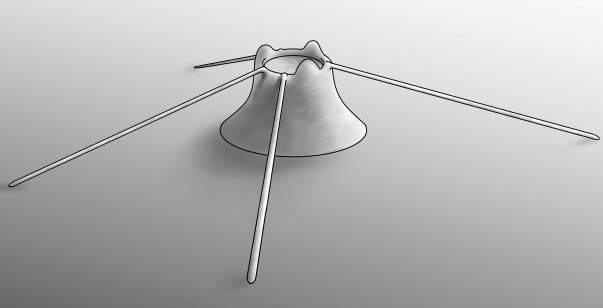The Cambrian era marked a profound change on life on Earth, sparking the rapid development of complex organisms and a diversification of the ecosystem, thus the term “Cambrian explosion“. Prior to this period, animals were simple and small, as well as soft bodied, with no hard parts to display. A team of paleontologists at University of California, Riverside, however, made a monumental discovery recently, namely they found fossil evidence for an organism with individual skeletal body parts dating from before the Cambrian. This makes it the earliest animal with a skeleton.

Artist impression of the Coronacollina, the earliest animal with a skeleton. (c) Daniel Garson for Droser lab, UC Riverside.
Dubbed Coronacollina acula, the animal is between 560 million and 550 million years old, placing it in the Ediacaran period, the first period of the Paleozoic Era and of the Phanerozoic Eon. The fossil was found in Australia, and after an exhaustive study, it was found to present a depression measuring a few millimeters to 2 centimeters deep – the Coronacollina acula. Since rocks compact over time, however, researchers believe it was actually somewhere 3 to 5 centimeters tall, featuring a thimble-shaped body. Attached to its body, at least four 20 to 40 cm long needle-like “spicules” were present, which the animal most likely used to keep itself atop, despite being considered incapable of locomotion. It lived on the seafloor.
“We now have an organism with individual skeletal body parts that appears before the Cambrian. It is therefore the oldest animal with hard parts, and it has a number of them – they would have been structural supports – essentially holding it up. This is a major innovation for animals,” said lead scientist Mary Droser.
Indeed this is terribly exciting news, one which most likely will go on to provide scientists with important insights. For instance, the creature’s structure resembles the manner in which Cambrian sponges were constructed, hence possibly providing a link between the two periods.
“We’re calling it the ‘harbinger of Cambrian constructional morphology,’ which is to say it’s a precursor of organisms seen in the Cambrian. This is tremendously exciting because it is the first appearance of one of the major novelties of animal evolution,” Droser says.
This link is of extremely important consequence, impacting current theories on the Cambrian explosion. For years, scientists believed that skeletons only appeared once with the Cambrian, and this latest remarkable find serves as evidence that Ediacaran animals are part of the evolutionary lineage of animals as we know them.
“The fate of the earliest Ediacaran animals has been a subject of debate, with many suggesting that they all went extinct just before the Cambrian,” Droser said. “Our discovery shows that they did not.”
“We often associate skeletons with predation since skeletons greatly assist animals in their fight against predators,” Droser said. “But Coronacollina acula used its skeleton only for support, there being no predators in the Ediacaran.”
The findings were published in the journal Geology.
University of California, Riverside press release via Scienceagogo









